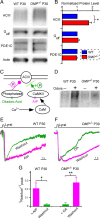Olfactory marker protein is critical for functional maturation of olfactory sensory neurons and development of mother preference
- PMID: 21414919
- PMCID: PMC3084592
- DOI: 10.1523/JNEUROSCI.5067-10.2011
Olfactory marker protein is critical for functional maturation of olfactory sensory neurons and development of mother preference
Abstract
Survival of many altricial animals critically depends on the sense of smell. Curiously, the olfactory system is rather immature at birth and undergoes a maturation process, which is poorly understood. Using patch-clamp technique on mouse olfactory sensory neurons (OSNs) with a defined odorant receptor, we demonstrate that OSNs exhibit functional maturation during the first month of postnatal life by developing faster response kinetics, higher sensitivity, and most intriguingly, higher selectivity. OSNs expressing mouse odorant receptor 23 (MOR23) are relatively broadly tuned in neonates and become selective detectors for the cognate odorant within 2 weeks. Remarkably, these changes are prevented by genetic ablation of olfactory marker protein (OMP), which is exclusively expressed in mature OSNs. Biochemical and pharmacological evidence suggests that alteration in odorant-induced phosphorylation of signaling proteins underlie some of the OMP(-/-) phenotypes. Furthermore, in a novel behavioral assay in which the mouse pups are given a choice between the biological mother and another unfamiliar lactating female, wild-type pups prefer the biological mother, while OMP knock-out pups fail to show preference. These results reveal that OSNs undergo an OMP-dependent functional maturation process that coincides with early development of the smell function, which is essential for pups to form preference for their mother.
Figures






Similar articles
-
Survival of mature mouse olfactory sensory neurons labeled genetically perinatally.Mol Cell Neurosci. 2018 Apr;88:258-269. doi: 10.1016/j.mcn.2018.02.005. Epub 2018 Feb 7. Mol Cell Neurosci. 2018. PMID: 29427775
-
Spatiotemporal alterations in primary odorant representations in olfactory marker protein knockout mice.PLoS One. 2013 Apr 22;8(4):e61431. doi: 10.1371/journal.pone.0061431. Print 2013. PLoS One. 2013. PMID: 23630588 Free PMC article.
-
Postnatal odorant exposure induces peripheral olfactory plasticity at the cellular level.J Neurosci. 2014 Apr 2;34(14):4857-70. doi: 10.1523/JNEUROSCI.0688-13.2014. J Neurosci. 2014. PMID: 24695705 Free PMC article.
-
Maturation of the Olfactory Sensory Neuron and Its Cilia.Chem Senses. 2020 Dec 5;45(9):805-822. doi: 10.1093/chemse/bjaa070. Chem Senses. 2020. PMID: 33075817 Free PMC article. Review.
-
The functional relevance of olfactory marker protein in the vertebrate olfactory system: a never-ending story.Cell Tissue Res. 2021 Jan;383(1):409-427. doi: 10.1007/s00441-020-03349-9. Epub 2021 Jan 15. Cell Tissue Res. 2021. PMID: 33447880 Free PMC article. Review.
Cited by
-
Alzheimer's Disease: What Can We Learn From the Peripheral Olfactory System?Front Neurosci. 2020 May 19;14:440. doi: 10.3389/fnins.2020.00440. eCollection 2020. Front Neurosci. 2020. PMID: 32508565 Free PMC article. Review.
-
Prevalent presence of periodic actin-spectrin-based membrane skeleton in a broad range of neuronal cell types and animal species.Proc Natl Acad Sci U S A. 2016 May 24;113(21):6029-34. doi: 10.1073/pnas.1605707113. Epub 2016 May 9. Proc Natl Acad Sci U S A. 2016. PMID: 27162329 Free PMC article.
-
Compensatory plasticity in the olfactory epithelium: age, timing, and reversibility.J Neurophysiol. 2015 Sep;114(3):2023-32. doi: 10.1152/jn.00076.2015. Epub 2015 Aug 12. J Neurophysiol. 2015. PMID: 26269548 Free PMC article.
-
Mild Fluid Percussion Injury Induces Diffuse Axonal Damage and Reactive Synaptic Plasticity in the Mouse Olfactory Bulb.Neuroscience. 2018 Feb 10;371:106-118. doi: 10.1016/j.neuroscience.2017.11.045. Epub 2017 Dec 2. Neuroscience. 2018. PMID: 29203228 Free PMC article.
-
Inhibition of focal adhesion kinase increases adult olfactory stem cell self-renewal and neuroregeneration through ciliary neurotrophic factor.Stem Cell Res. 2020 Dec;49:102061. doi: 10.1016/j.scr.2020.102061. Epub 2020 Oct 23. Stem Cell Res. 2020. PMID: 33130470 Free PMC article.
References
-
- Alberts JR, Brunjes PC. Ontogeny of thermal and olfactory determinants of huddling in the rat. J Comp Physiol Psychol. 1978;92:897–906. - PubMed
-
- Alberts JR, May B. Development of nasal respiration and sniffing in the rat. Physiol Behav. 1980a;24:957–963. - PubMed
-
- Alberts JR, May B. Ontogeny of olfaction: development of the rats' sensitivity to urine and amyl acetate. Physiol Behav. 1980b;24:965–970. - PubMed
-
- Belluscio L, Gold GH, Nemes A, Axel R. Mice deficient in G(olf) are anosmic. Neuron. 1998;20:69–81. - PubMed
-
- Blass EM, Teicher MH. Suckling. Science. 1980;210:15–22. - PubMed
Publication types
MeSH terms
Substances
Grants and funding
LinkOut - more resources
Full Text Sources
Molecular Biology Databases
